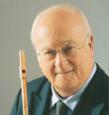Flutists argue about ways to tongue. Some allow the tip of the tongue to show between the lips, whereas others feel such a practice is obscene or tabu. On the other hand, some conclude the French tongue faster, which does not mean better, because their enunciation is dryer and crisper than those who speak other languages. Practicing solfege helps articulation, but those who tongue fastest and best are those who practice tonguing, for which there are no shortcuts. During practice one discovers fascinating things about the flute and self. If something works, by all means do it, even if it means sticking out your tongue.
Consider logically what tonguing and attacks should not do:
- Break the notes, which can happen if the lip aperture is either too close or too far from the edge of the mouthpiece.
- Alter the quality of the sound; staccato at whatever speed only slightly interrupts the tone.
- Weaken the dynamics.
- Slow the tempo.
- Be too obvious to the listener.
- Be without variation.
The range of articulation begins with legato, meaning tied, for slurred notes; staccato, which means separated or detached; louré, comparable to a slightly interrupted bowing (sometimes erroneously called legato); modulated tonguing to be separated without interrupting the sound; to dotted; to spiccato. Years ago the tear drop mark over the notes did not imply the note should be louder, but rather, there should be space around the note; for example, see Couperin’s Concert Royal No. 4, "Rigaudon."
Neither the tempo of the passage nor the player’s musical taste should dictate single or double tonguing. No listener should be able to detect one from the other; in fact, practicing scales correctly allows the player to switch from single to double tonguing unnoticeably.
If the tongue is too far back in the mouth, the attack will be fuzzy, broken, or too loud. Without placing the tongue between the lips, it should be as close to the aperture as possible. By tonguing long notes between the lips, the tongue moves only backwards. When preparing to tongue a long note, the tip of the tongue shows slightly. With support also prepared, (the softer or more difficult the attack, the stronger the support) imperceptibly release a bit of air through the nose; then to start the sound, pull fast on the tongue to make a proper attack. During my tenure with the Orchestre de Paris, I developed this technique playing under great conductors, some who had unclear beats. If this type of attack helps create a better sound, live with it and develop the procedure.
For a proper concept of staccato, do not use too much air. Experiment by listening to the way a staccato run sounds at the end of your breath just before you run out. For a forte low register or pianissimo high register staccato inhale very little if you can afford it; if the passage is long, support the tone but hold back on the volume. For staccato runs, it is not possible to let the tongue show on every note. Although some French teachers request entire passages be played in this manner, they are not in the majority.
Try to create the staccato sound more through the stability of the left hand than with the volume of air. Don’t blow like an ox to get a big sound, and don’t let the cheeks be flappy. Otherwise you will have sloppy attacks and a fuzzy staccato. The air should vibrate, not the face. Keep in mind the staccato articulation interrupts the sound on every note and takes the dynamic level down at least one level: forte becomes mezzo forte, and piano becomes pianissimo. If you need to play a louder staccato focus more and keep the stability in the left hand. For an echo effect, play forte to fortissimo, then echo by playing a staccato articulation, which is better than systematically fighting the instrument.
Adapt the staccato to the music being played. You will not tongue the same way in Syrinx as you would for Berio’s Sequenza or in Brahms’ Symphony No. 2. Practice staccato on a wide array of scales in all keys at all tempos and at every dynamic level each week. The tempo should be comfortable, not fast. Establishing the proper tempo is essential and is the common denominator between fingers and tonguing. Don’t try to slam the tongue with clumsy fingers, or slap the fingers using a heavy tongue.
Practice by repeating notes: play twice each note of a scale using double or triple tonguing; on another scale repeat each note three times, then four, six, and finally eight times using Scale Games 12-16. Practice eight notes plus one, as in Scale Games 39, and use off-balance attacks and staccato for Scale Games 41-42. Try single tonguing without the tongue, using support only, as in Scale Game 5. Then practice double tonguing with only the ku syllable in Scale Game 58. Finally, use a composite of single and double tonguing for Scale Games 29 and 30.
Although this is a slow process, it is the only way to practice staccato. A solid articulation is like having a set of tools in your pocket that you can use without thinking about it, just as we speak in our native tongue.






